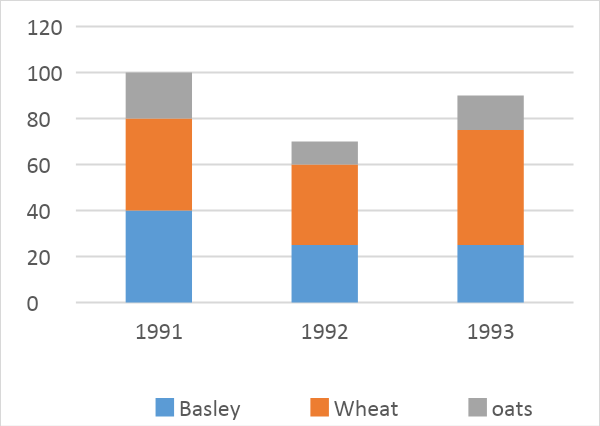
Given a sub-divided bar graph which represents the production of wheat, oats and barley in three consecutive years, what is the percentage production of wheat in the year 1993?

$ a)40.55\%$
$ b)50.55\% $
$ c)45.55\% $
$ d)55.55\% $

Answer
564k+ views
Hint: Now we are given a graph representing production of wheat, oats and barley in three consecutive years. So we will calculate the production of wheat in the year 1993 as well as the total production in the year. Now percentage of wheat is given by $\dfrac{\text{production of wheat}}{\text{total production}}\times 100$
Complete step-by-step answer:
Now we have the given subdivided bar graph has the representation production of wheat, oats and barley in three consecutive years.

Now to read the graph we will find the height of each corresponding bar
For example we want to calculate the production of Wheat in 1991. Then we will find the height of the bar representing wheat in 1991. Now height is 80 – 40 = 40. Hence the production of wheat in 1991 was 40.
Let us consider the year 1993.
Now in 1993 the production of Basley was 25, production of Wheat was 75 – 25 = 50. and the production of oats is 90 – 75 = 15.
Hence we can say the total production was 25 + 50 + 15 = 90.
Now we know that percentage of wheat production can be calculated by
$\dfrac{\text{production of wheat}}{\text{total production}}\times 100$
Hence we have the percentage of wheat production is $\dfrac{50}{90}\times 100=55.55$
Hence the production of wheat was 55.55 percent.
So, the correct answer is “Option d”.
Note: Now we can also do this in a shortcut way. We know that the production of wheat in 1993 was 50 because the length of the bar graph representing wheat is 50. Now we need not calculate the total production as the total production is nothing but the total height of the bar graph. Hence we easily get that the total production in 1993 was 90.
Complete step-by-step answer:
Now we have the given subdivided bar graph has the representation production of wheat, oats and barley in three consecutive years.

Now to read the graph we will find the height of each corresponding bar
For example we want to calculate the production of Wheat in 1991. Then we will find the height of the bar representing wheat in 1991. Now height is 80 – 40 = 40. Hence the production of wheat in 1991 was 40.
Let us consider the year 1993.
Now in 1993 the production of Basley was 25, production of Wheat was 75 – 25 = 50. and the production of oats is 90 – 75 = 15.
Hence we can say the total production was 25 + 50 + 15 = 90.
Now we know that percentage of wheat production can be calculated by
$\dfrac{\text{production of wheat}}{\text{total production}}\times 100$
Hence we have the percentage of wheat production is $\dfrac{50}{90}\times 100=55.55$
Hence the production of wheat was 55.55 percent.
So, the correct answer is “Option d”.
Note: Now we can also do this in a shortcut way. We know that the production of wheat in 1993 was 50 because the length of the bar graph representing wheat is 50. Now we need not calculate the total production as the total production is nothing but the total height of the bar graph. Hence we easily get that the total production in 1993 was 90.
Recently Updated Pages
Why are manures considered better than fertilizers class 11 biology CBSE

Find the coordinates of the midpoint of the line segment class 11 maths CBSE

Distinguish between static friction limiting friction class 11 physics CBSE

The Chairman of the constituent Assembly was A Jawaharlal class 11 social science CBSE

The first National Commission on Labour NCL submitted class 11 social science CBSE

Number of all subshell of n + l 7 is A 4 B 5 C 6 D class 11 chemistry CBSE

Trending doubts
What is meant by exothermic and endothermic reactions class 11 chemistry CBSE

10 examples of friction in our daily life

One Metric ton is equal to kg A 10000 B 1000 C 100 class 11 physics CBSE

1 Quintal is equal to a 110 kg b 10 kg c 100kg d 1000 class 11 physics CBSE

Difference Between Prokaryotic Cells and Eukaryotic Cells

What are Quantum numbers Explain the quantum number class 11 chemistry CBSE




